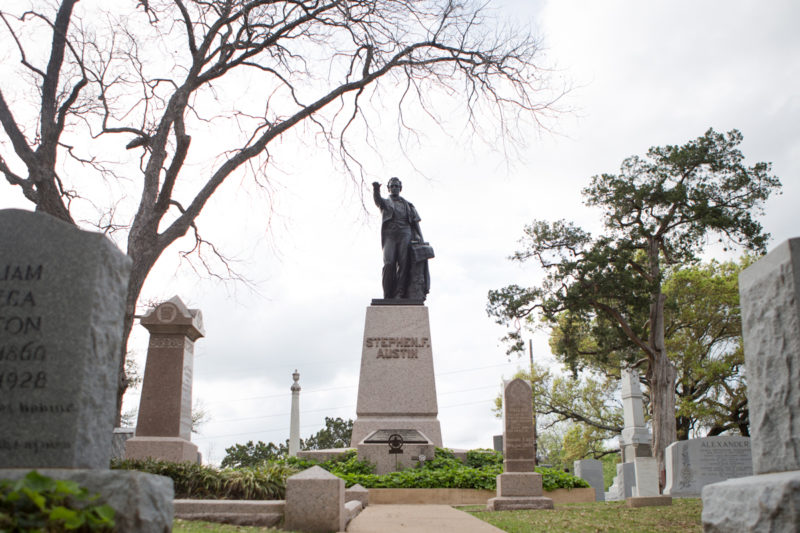For Famous and Fortunate Texans, Life’s Road Ends at State Cemetery
By Azriel Hebrado
Reporting Texas

A statue of Stephen F. Austin, the founder of Texas, looms over his grave at the Texas State Cemetery. Lynda Gonzalez/Reporting Texas
The Texas State Cemetery on Austin’s east side is the final resting place for many an iconic Texan who left their mark on history in an outsized way.
For starters, there’s Stephen F. Austin, founding father of Texas, followed by Barbara Jordan, Ann Richards and other politicians. There’s University of Texas football coaching legend Darrell K Royal, at least one opera diva and Larry L. King, “the lion of Texas letters,” who co-wrote the hit musical “The Best Little Whorehouse in Texas.”
In January, astronaut Eugene Cernan, the last man to plant a foot on the moon, joined the cemetery’s crowd. Former President George W. Bush has said he wants to be interred there when the time comes.
“You can get every aspect of Texas history and culture, from European colonization, to Texas Independence, the Civil War, to 20th Century Texans,” said Jason Walker, the cemetery’s director of research, “all buried here at the cemetery.”
How does an aspiring person get the nod to join such an illustrious gathering of the departed? The club isn’t as elite as one might think.
The requirements, enshrined in state law, seem daunting. According to the Texas Government Code, Chapter 2165, Section 256, subsections d and e, to be exact, the prospective dead are to be either former members of the Legislature, an elected state official or someone who died in office.
But there are other avenues for the dead: being tapped by a sitting governor or voted in by the Texas State Cemetery Committee.
“If an individual does not meet the automatic eligibility requirements,” Walker said, “then they must go through an application process.” That requires submitting biographical data, supporting documentation in the form of newspaper and magazine articles, and letters of support from public officials or community leaders.
In certain cases, the cemetery extends an invitation. Gregg Cantrell, 58, a historian at Texas Christian University, says he was approached. “I’m not sure what the specific eligibility requirements are,” he said, adding he’s reasonably sure his nomination is related to his scholarly reputation and the books and articles he’s written on Texas history.
Whichever your path of entry, there still appears to be plenty of room. Founded in 1851 on the death of Edward Burleson, a hero of the Republic of Texas and its third vice president, the state-funded, 22-acre tract east of I-35, at Seventh and Navasota streets, has space to accommodate up to 9,000 graves. Will Erwin, the cemetery’s senior historian, said about 55 percent of the graves are occupied.
Not everyone buried at the cemetery is there because they were invited or applied. Sometimes remains were moved from another burial place—most notably, perhaps, those of Stephen F. Austin.
The venerated Texas statesman died in 1836, 15 years before the cemetery was established, and originally was buried at the Gulf Prairie Cemetery in Brazoria County. His remains were moved to the State Cemetery in 1910, 74 years after his passing.
Transporting the departed grew in popularity after the Legislature passed a law providing for the reburial of prominent Texans in the cemetery, said Erwin. Between 1929 and 1936, businessman Louis Kemp oversaw the reinterment of some 70 individuals.
“Louis Kemp made it his mission to rebury many Republic of Texas figures here in Austin so their graves wouldn’t be lost,” Erwin said. After Kemp died in 1956, he was laid to rest in the cemetery, though not until seven months after he had been interred at another site.
There’s been one more way to gain entry into the state cemetery. “The most unexpected burial would have to be a former legislator’s burro,” Walker said.
“Back in the late 19th and early 20th centuries, legislators would have their horses or other animals graze on the north end of the cemetery,” Walker said. “Apparently … a burro died unexpectedly, and they buried it on the side of the hill.”